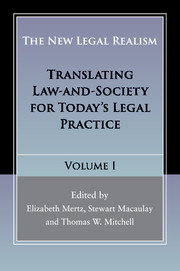Book contents
- Frontmatter
- Contents
- List of contributors
- Preface to The New Legal Realism, Volumes I and II
- 1 Introduction: New Legal Realism: Law and Social Science in the New Millennium
- Section I THE PLACE OF NEW LEGAL REALISM IN LEGAL THOUGHT AND TEACHING
- 2 A New Legal Realism: Elegant Models and the Messy Law in Action
- 3 Putting the “Real World” into Traditional Classroom Teaching
- 4 Some Realism about Realism in Teaching about the Legal Profession
- 5 “Fielding” Legal Realism: Law Students as Participant-Observers?
- Section II PHILOSOPHY AND METHODS FOR A NEW LEGAL REALISM
- Section III NEW LEGAL REALIST TRANSLATIONS
- Index
- References
4 - Some Realism about Realism in Teaching about the Legal Profession
from Section I - THE PLACE OF NEW LEGAL REALISM IN LEGAL THOUGHT AND TEACHING
Published online by Cambridge University Press: 05 May 2016
- Frontmatter
- Contents
- List of contributors
- Preface to The New Legal Realism, Volumes I and II
- 1 Introduction: New Legal Realism: Law and Social Science in the New Millennium
- Section I THE PLACE OF NEW LEGAL REALISM IN LEGAL THOUGHT AND TEACHING
- 2 A New Legal Realism: Elegant Models and the Messy Law in Action
- 3 Putting the “Real World” into Traditional Classroom Teaching
- 4 Some Realism about Realism in Teaching about the Legal Profession
- 5 “Fielding” Legal Realism: Law Students as Participant-Observers?
- Section II PHILOSOPHY AND METHODS FOR A NEW LEGAL REALISM
- Section III NEW LEGAL REALIST TRANSLATIONS
- Index
- References
Summary
In 2009, the founding faculty of UC Irvine Law School decided to adopt a required first-year course on the Legal Profession. Our purposes were to introduce students to the rich empirical literature on the profession and to give them an understanding of practice realities and critical perspectives on those practices. We hoped, in so doing, that we would both pursue the legal realist goal of reforming legal education to give greater emphasis to interdisciplinary study of law and better prepare our students for law practice by presenting them with an array of scholarship on the legal profession. We believe the course achieves these goals, at least to some extent, even as we continue to encounter the challenges in incorporating legal realism into the first-year law school curriculum. This chapter briefly describes the course's purposes, its content, and our experience while teaching it.
THE PURPOSES OF THE COURSE AND THEIR RELATION TO NEW LEGAL REALISM
The ABA requires all law schools, as a condition for accreditation, to provide substantial instruction in “the history, goals, structure, values, rules, and responsibilities of the legal profession and its members.” Most law schools meet that standard by requiring their students to take a two- or three-unit course called “professional responsibility” or “ethics.” Those courses typically emphasize the rules of professional conduct and target second- and third-year students. UCI's founding faculty decided to take a different approach, by adopting a course that would make coverage of ethics rules secondary to a related but broader purpose – educating our students about the legal profession to help them to chart successful, responsible, and rewarding careers. The course would situate ethical issues in a larger examination of the history and social structure of the profession, the market for legal services, and the conditions of practice. We also decided that students should take the course in their first year so that they could immediately begin their search for a good fit between their aptitudes and values and opportunities in the profession. Finally, the course would carry four units rather than the usual two or three units, signaling to students that it was as important as their other first-year courses.
The most basic premise of the course is that law schools should provide students with information and perspectives about the legal profession and law practice that will help them navigate their careers.
- Type
- Chapter
- Information
- The New Legal RealismTranslating Law-and-Society for Today's Legal Practice, pp. 74 - 94Publisher: Cambridge University PressPrint publication year: 2016



